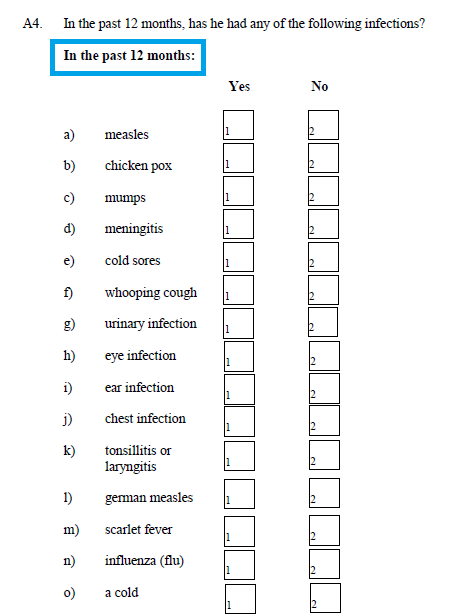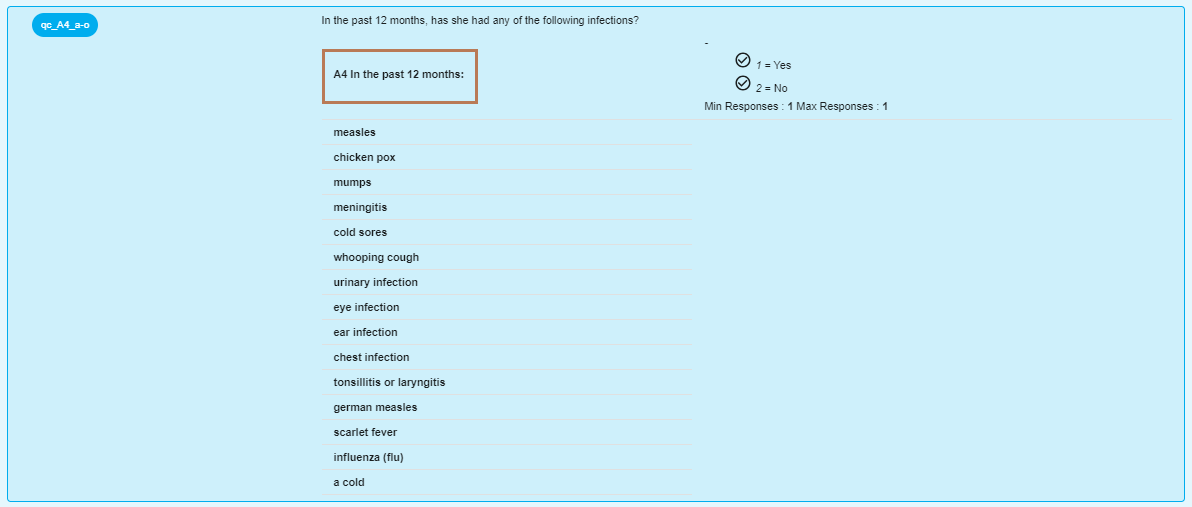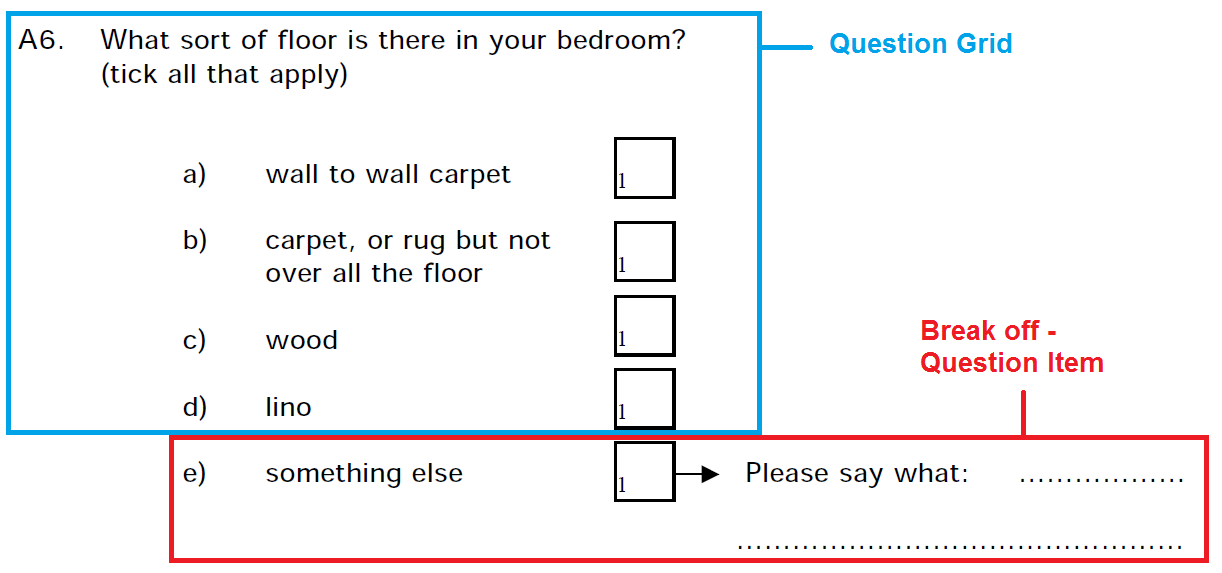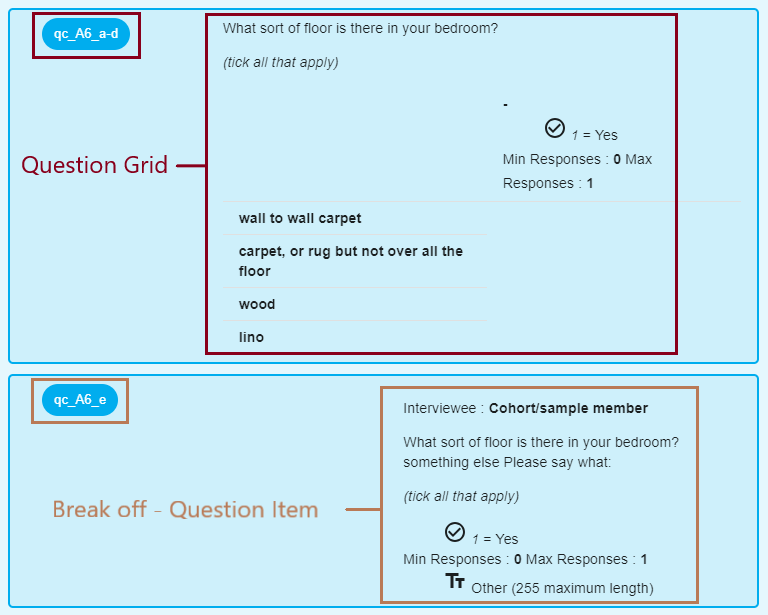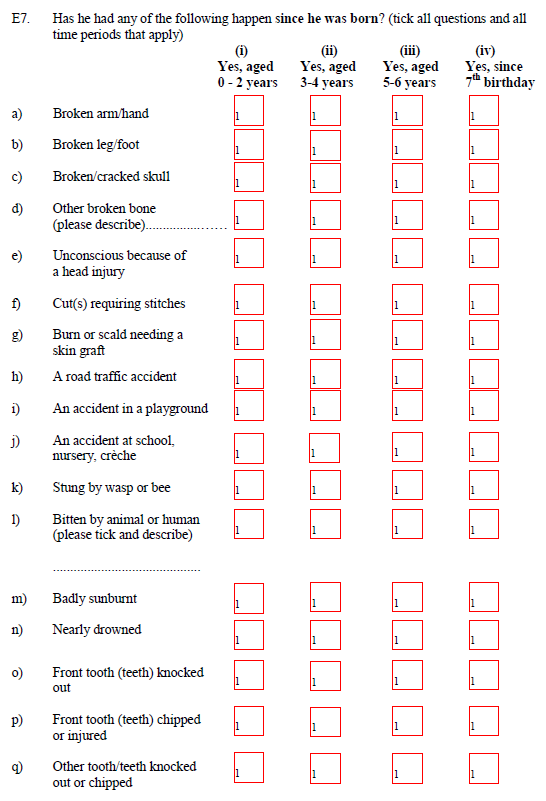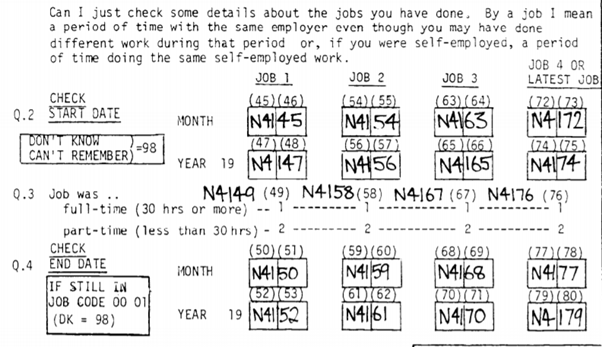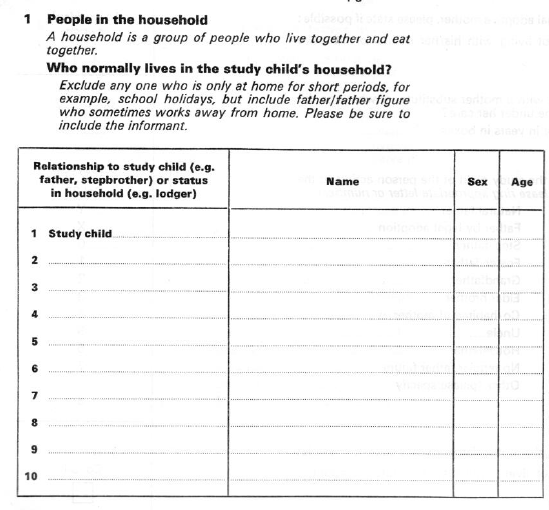Key Considerations
- Only use for multi-column grids.
- For questions to be input as a grid, there must be overarching text that can be input as the grid literal.
- Questions laid out as a table in a questionnaire are not necessarily entered as grids.
- All questions (Y axis) in the grid must have the same response(s) (X axis). In some cases, questions with different responses may be broken off from the grid and input as a separate question.
- When a group of repeated questions has overarching text containing important information (who, when and where) about the loop, then a grid is used to more strongly connect the questions to the defining overarching text.
When entering groups of related questions, lists of questions, or tables in Archivist, it can be useful to use a question grid to express the information rather than separate question items.
It is important to remember that original information appearing in a table does not mean that it should always be represented as a question grid in Archivist. The intent of metadata archiving is to record the semantic meaning and order of the questionnaire, not the exact style of presentation.
The key feature of a question to look for when assessing whether a question is a grid or not is whether the question has an overarching question with multiple sub-questions or statements. In Example 1, if the overarching text "How many of the following paid teaching staff work with your class? (Do not include teachers who do individual tuition for music or special needs)" is removed, the overall question would lose meaning, becoming an abstract list.
For information about deciding when to use a question grid, see the Questions page.
Grid architecture
Grids work by translating related questions into positions on an X and Y axis.
When deciding what aspects of a question to assign to which axis/header, the X axis usually hosts the answers/response domains, and the Y contains the questions. Code lists are used to construct these respective axes, usually labelling both with the question number followed by a '_X' or '_Y'. In some cases, these code lists are labelled differently according to the structural needs of the grid (see Construct a Label).
Example 1 Questionnaire: ALSPAC About your Class
Questionnaire layout:
Archivist view (alspac_00_ayc):
Grid axes labels
Depending on the question, question grids can contain single or multiple columns on the X axis to hold a mixture of response domains.
Single-column grids
In the past, we have entered lists of sub-questions as single-column grids. Example 2 shown below, is a single-column grid, it has as many rows as it needs for all the questions (five in this case) and then one column to address the code answer for all of these, '1 - Yes'. Current protocol is to enter these as single question items by concatenating the overarching question text and the sub-question question text. The examples below may still be useful in understanding the grid structures but would not be entered as grids any longer.
If there is no clear label for the column, a dummy heading is used to maintain structure. This is done by creating a code list with a single category of a hyphen ( - ), which the required code answer is attached to. This is always labelled cs_dash.
The cs_dash code list used to structure the X axis of the grid (boxed in green), with the code answer '1 - Yes' attached to it can be seen in Example 2 below.
Example 2 Questionnaire: ALSPAC About Your Class 2000
Questionnaire layout:
Archivist Build / Code Lists:
Archivist view (alspac_00_ayc):
Multi-column grids
Example 3 shows a grid with multiple columns, headed by three categories in its X axis code list. The three categories have response domains attached to them, addressing the three parts of each question section. A mixture of two numeric answers and one text answer (Age, Generic Text, How Many).
Example 3 Questionnaire: ALSPAC My Son/Daughter's Health
Questionnaire layout:
Archivist Build / Code Lists:
Archivist view (alspac_00_msdh):
Sometimes a grid looks like it has multiple columns because of the way a code list is laid out, but pay attention to what the columns represent. In Example 4, the grid appears to have a number of columns, however this would not count as a multi-column grid because each question is answered by the same set of code list options: each column is not asking for a different piece of information.
Example 4 Questionnaire: My Son/Daughter at Home and at School
Questionnaire layout:
Archivist view (alspac_00_msdhs)
Corner labels
On occasion, groups of questions are laid out in such a way that they have a small sub-heading which adds information to one of the axes of the grid. This is not quite overarching question text, or an instruction, and would be out of context as a statement. In this case, we can use the corner label function of question grids. The corner label is added to the to either axis, this is done by naming the code list label the corner label text and selecting a corner label when building the grid for either the X or Y axis.
Example 5 shows how a corner label appears in the original questionnaire, and how this is entered in Archivist. Both versions of the corner label are boxed in blue. The example shows the corner label entered as "A4 In the past 12 months:". Note the question number has been entered in addition to the corner text as "In the past 12 months:" is used in several questions throughout the questionnaire. The label must still be unique, therefore a unique identifier is added, which is striped out before being deposited in CLOSER Discovery. A label.txt file is created which contains the label as entered in archivist, followed by the correct sequence name (tab separated).
Note this would no longer be entered as a question grid, but as separate question items with the literal concatenated as "In the past 12 months, has he had any of the following infections? In the past 12 months: measles"
Example 5 Questionnaire: ALSPAC My Son/Daughter's Health 2000
Questionnaire layout:
Archivist build / Code Lists:
Archivist Build / Question Grid:
Archivist view (alspac_00_msdh):
Break-off questions
Single-column grids
Questions are 'broken off' from their group in a grid if the response domain in the list of questions changes in some way. For example, if a question grid has a single column on the X axis and there is a Y axis item with a different response domain from the others or a mixed response domain (for example a code list and a text response), that question is broken off from the grid and entered as a separate question item. If the item is numbered/lettered, for example the letter e in Example 6, it is included in the qi and qc labels for the separate question item.
Note this would no longer be entered as a question grid, but as separate question items.
Example 6 Questionnaire: ALSPAC My World
Questionnaire layout:
Archivist view (alspac_00_mw):
Multi-column grids
If the questionnaire grid has multiple columns on the X axis and there is a Y axis item with an additional text answer, the item is left in the grid with the response domain it has in common with the other Y axis items. However, it is also repeated as a single question item after the grid to address the text answer.
See Example 7 below, pay particular attention to how d) is repeated inside and outside of the grid in the Archivist view. This also occurs with l) 'Bitten by animal or human (please tick and describe) ...' further down question E7.
Example 7 Questionnaire: ALSPAC My Son/Daughter's Health
Questionnaire layout:
Archivist view (alspac_00_msdh):
Entering repeated questions as a grid
- Both loops and grids can be used to input series of repeating questions. In most cases, a loop would be the preferred choice for adding repeating questions in Archivist.
- When a group of repeated questions has overarching text containing important information about the loop, then a grid is used to more strongly connect the questions to the defining overarching text (See the example 8 below)
For a group of questions to be input as a grid, there must be overarching text to add as the grid literal. When this text is missing, a loop can be used to input the repeating questions (see Example 2 on Loops)
Example 8 Questionnaire: NCDS Age 23 Cohort Member Interview
Questionnaire layout:
Archivist view (ncds_81_i):
Rosters
Rosters represent situations where the respondent extends the Y axis with further information that meets the requirements of the question. These were previously known as editable rows. In Example 9, the respondent is asked to list up to nine extra members of their household after the stated member ( 'Study child') and then give repeating details about them, in this case their name, sex and age. Study child, is entered into the Y axis code list and then rosters are used for the remaining 9 spaces in the Y axis.
Example 9: Questionnaire: NCDS Parental interview form 1974
Questionnaire layout:
Archivist build / Code Lists
Archivist build / Question Grid:
Archivist view (ncds_74_pq):





